It’s long been a tradition for British comics aimed at girls to be given a girls’ name (that is, a name we tend to commonly associate with female people), but — not counting those whose title is the name of a character like Batman or Popeye — how many comics can you list that have a boy’s name?
Well, not as many as have been given names that we traditionally associate with girls, that’s for sure. So what is the ratio of comics with girls’ names to comics with boys’ names? For no reason other than a bit of an oul’ laugh, let’s have a look, shall we? Yes, we shall!
First, we need to define the parameters…
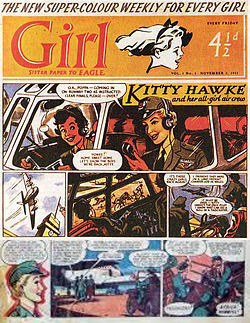
The main rule is that the title must be the sort of name you could give your child without someone sneering and saying, “Really?” or having the neighbours speculate amongst themselves whether they ought to be phoning someone in authority. This means that while DC Thomson’s Victor might seem like a viable candidate it doesn’t really count here because the comic’s original name is The Victor.
I also don’t want to include full names, such as “Ally Sloper” — we’re looking for single names only. Likewise, although “Rupert” is a perfectly respectable name if you’re a dislikeable distant cousin in an Enid Blyton book, Rupert Weekly doesn’t count in this case because it’s got that “Weekly” tacked onto the end there.
We’re also not counting made-up names Vampirella or Zorro or Tarzan or any of that lot.
Here we go…
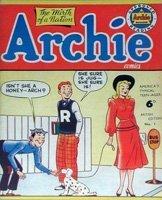 Archie
Archie
(Swan, 1950, 9 issues)
Right out of the gate, the first one is not a stepping stone but a bit of a stumbling block: the cover gives the title as “Archie Comics” (with “comics” in tiny little letters) but it’s referred to everywhere as simply “Archie,” so that’s what I’m sticking to. These are reprints of the American comics of the same name. You know: the ones that look like they’re going to be funny.
Robin
(L. Miller and Son, Ltd., 1952, 10 issues)
This comic (and its title character) were apparently later renamed “Pango,” but this still counts. And “Robin” is an androgynous name, too, which is handy. (In a trick frequently employed by L. Miller, the first issue of this comic was numbered #50 in order to give the impression that it had been around for a while, and was therefore successful.)
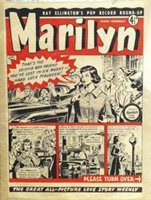 Marilyn
Marilyn
(AP, 19 Mar 1955 to 18 Sep 1965, 547 issues)
Presumably named in order to conjure an association with Marilyn Monroe. I wonder if she ever knew about it?
Mirabelle
(Pearson/IPC, 10 Sep 1956 to 22 Oct 1977, 1009 issues)
Another romance title, but I can’t think of any famous Mirabelles right now. It’s a great name but one that’s usually only ever applied to canal barges, or to the lone cow in a fictional dairy farm.
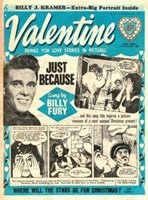 Valentine
Valentine
(AP/Fleetway, 19 Jan 1957 to 09 Nov 1974, 927 issues)
Traditionally this is a male name, but not exclusively. Here, it’s used because of the romantic connotations and not because of the famous gangland massacre.
Romeo
(DC Thomson, 31 Aug 1957 to 14 Sep 1974, 890 issues)
As with Valentine, the title is meant to reflect the archaic notions of romantic love, as if that’s a logical reason to seek out a life-partner. Tch. Why isn’t there a comic called Plato, eh?
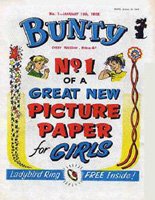 Bunty
Bunty
(DC Thomson, 18 Jan 1958 to 17 Feb 2001, 2249 issues)
“Bunty” is actually a real name, but right now I can only recall Bunty James, one of the presenters of How, a kids’ TV show that showed how stuff was done. (At the top of the program the four presenters greeted the audience with their palms up and a cry of “How!” in a manner traditionally associated with Native Americans. Not sure that would work today…)
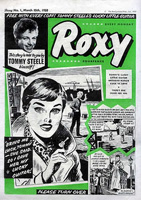 Roxy
Roxy
(AP, 15 Mar 1958 to 14 Sep 1963, 235 issues)
One of the few comics that’s named after that fleapit cinema in the next town over that used to show The Rescuers on Saturday mornings when you were a kid. (Also later immortalised by The Police in their famous song about a woman who mistakenly thought she was only allowed to activate a light of one colour — I think I’ve got that right.)
Judy
(DC Thomson, 16 Jan 1960 to 11 May 1991, 1635 issues)
There was a famous British satire magazine called Punch that ran from 1840 to 1992 and spawned a lot of imitators, including Judy, or the London Serio-Comic Journal (1867 to 1907, 2113 issues). This Judy wasn’t named after that one, though.
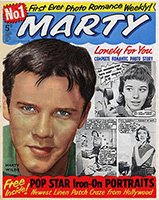 Marty
Marty
(Pearson, 23 Jan 1960 to 23 Feb 1963, 161 issues)
Another androgynous name, but in this case we know that the Marty in question was male, because the cover of the first issue featured the pop-star Marty Wilde (or, as a version of me in another reality refers to him, my father-in-law).
Buster
(Fleetway/IPC, 18 May 1960 to 04 Jan 2000, 1902 issues)
As I’ve mentioned many times before, I loved this comic! Okay, so “Buster” isn’t a very common first name, but it is real. Famous Busters include Keaton, Bloodvessel and Crabbe (coincidentally, that’s also the name of the legal firm that keeps sending me rather stern letters on behalf of a certain well-known pop-star).
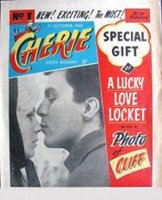 Cherie
Cherie
(DC Thomson, 01 Oct 1960 to 19 Oct 1963, 160 issues)
At first, I wasn’t going to include it because chérie is a French word meaning “darling” but then I realised there were plenty of people who use it as a real name. Cherie Blair, for example. There: never thought we’d see her name on a comics blog, did we?
June
(Fleetway/IPC, 18 Mar 1961 to 15 Jun 1974, 690 issues)
One of the very few comics named after a month. Possibly the only one. There’s a prize for the first person who can be bothered to name another one.
Diana
(DC Thomson, 23 Feb 1963 to 04 Dec 1976, 720 issues)
I don’t know very much about this one, other than that one of its strips was “The Avengers,” an adaptation of the cult TV show, not the Marvel superheroes.
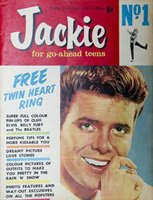 Jackie
Jackie
(DC Thomson, 11 Jan 1964 to 03 Jul 1993, 1534 issues)
Definitely more of a magazine than a comic, but it did have a few comic strips, as well as photo-stories about girls who ended up with their bad boyfriend’s less dynamic but nicer friend.
Mandy
(DC Thomson, 21 Jan 1967 to 11 May 1991, 1269 issues)
The weekly comic that lent its name to the Mandy Picture Story Library for Girls, as featured recently on this very blog.
Tina
(Fleetway, 25 Feb 1967 to 16 Sep 1967, 30 issues)
This one was later relaunched as Princess Tina but that falls outside the rules.
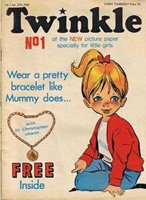 Twinkle
Twinkle
(DC Thomson, 27 Jan 1968 to 05 Jun 1999, 1638 issues)
Not really a proper name, but I’m counting it because it’s also the name of Maxine Peake’s character in the classic sitcom dinnerladies (even though she might well have been named after the comic).
Sally
(IPC, 14 Jun 1969 to 27 Mar 1971, 94 issues)
Not one that’s ever crossed my path so I don’t know much about it, sorry.
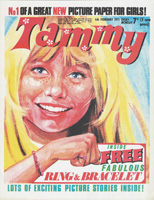 Tammy
Tammy
(IPC, 06 Feb 1971 to 23 Jun 1984, 699 issues)
A classic comic that pretty much trampled all the competition for a few years. A voracious title, it absorbed June, Sally, Sandie, Jinty, Misty and the 1980s version of Princess, before it was absorbed into the 1980s version of Girl.
Esmeralda
(IPC, 12 Jun 1971 to 30 Jan 1972, 33 issues)
A relaunch/rebranding of a nursery-age comic called Seven, which ran for sixteen issues from 20 Feb 1971 to 05 Jun 1971).
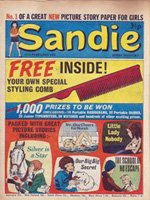 Sandie
Sandie
(IPC, 12 Feb 1972 to 20 Oct 1973, 89 issues)
Technically this could be an androgynous name, but the “ie” at the end makes people think of it as more feminine than masculine.
Debbie
(DC Thomson, 17 Feb 1973 to 15 Jan 1983, 518 issues)
I’ve covered an issue of Debbie in my semi-irregular Pocket-Money Comics series.
Bonnie
(IPC, 16 Mar 1974 to 10 May 1975, 61 issues)
One of the few comics that were named after notorious 1930s gangsters. (See also Valentine, above.)
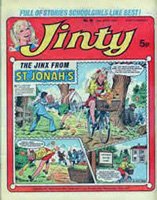 Jinty
Jinty
(IPC, 11 May 1974 to 21 Nov 1981, 393 issues)
I still don’t believe that this is a real name. I can’t even think of any names that might conceivably have turned into “Jinty” via some sort of reasonably credible typographical error.
Lindy
(IPC, 21 Jun 1975 to 01 Nov 1975, 20 issues)
Also not a real name, is it? Plus, this one was absorbed by Jinty, which I suspect was done just to annoy me.
Toby
(IPC, 30 Jan 1976 to 30 Sep 1978, 88 issues)
OK, this comic’s title character is a dog, but it still counts.
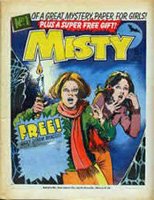 Misty
Misty
(IPC, 04 Feb 1978 to 12 Jan 1980, 102 issues)
Another one that’s not really a proper name, but I’m including it because Misty was a classic comic, and I had a bit of a crush on the title character (still do, actually).
Emma
(DC Thomson, 25 Feb 1978 to 08 Sep 1979, 83 issues)
This is a comic about which I know very little… I do have a few copies but I don’t think I’ve ever read them.
Penny
(IPC, 28 Apr 1979 to 05 Apr 1980, 45 issues)
Same with this one, actually. (Although I do harbour a secret hope that Penny’s surname is “Farthing.”)
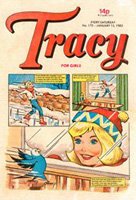 Tracy
Tracy
(DC Thomson, 06 Oct 1979 to 19 Jan 1985, 277 issues)
On this side of the Atlantic “Tracy” is definitely a girls’ name, true, but I’m going to say “Tracy Walter” and leave it at that.
Buddy
(DC Thomson, 01 Feb 1981 to 06 Aug 1983, 130 issues)
More of a nickname, but there are real people in the USA with the name “Buddy” — and why not, if they’re also going to insist that “Guy” is a name?
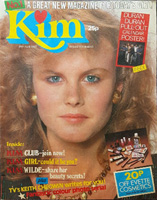 Kim
Kim
(Marvel UK, 24 Apr 1982 to 02 Jun 1983, 59 issues)
An androgynous name – but my pet theory is that this mag was named after Kim Wilde, daughter of the aforementioned Marty (that’s probably not true, but I defy anyone to prove otherwise by introducing me to Kim Wilde so we can hear her side of the story in person).
Suzy
(DC Thomson, 10 Sep 1982 to 13 Jun 1987, 249 issues)
Suzy was a half-way point between DC Thomson’s comics (untrimmed newsprint paper with black and white drawings) and their teenagers’ mags with higher-quality production.
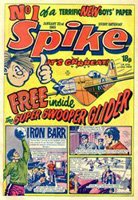 Spike
Spike
(DC Thomson, 22 Jan 1983 to 28 Apr 1984, 67 issues)
Again, like Buddy this is more likely to be a nickname, but there are a few real people called “Spike,” most notably the legendary director Spike Lee, after whom the comic is not named. I’m counting this one as a male name, but it works just as well for girls.
Robin
(IPC, 19 Jan 1985 to 29 Jun 1985, 20 issues)
A revival in name only of the Hulton comic (junior companion to Eagle) which doesn’t appear here because that one was called The Robin.
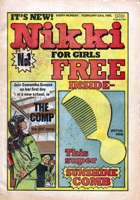 Nikki for Girls
Nikki for Girls
(DC Thomson, 23 Feb 1985 to 09 Sep 1989, 237 issues)
I’m breaking the “only the character’s name” rule for this one because “for girls” is sort of tacked on as an afterthought just in case anyone thought it was named after Nik Kershaw, which it wasn’t but should have been.
Jem
(London Editions, 30 Oct 1986 to 02 Apr 1987, 12 issues)
Based on the cartoon show Jem and the Holograms, apparently, which I’ve never seen. But this still counts.
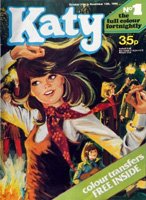 Katy
Katy
(IPC, 31 Oct 1986 to 06 Mar 1987, 10 issues)
A fortnightly comic that included re-coloured reprints from Misty, Tammy and Jinty, with covers reused from issues of Princess Tina.
Alf
(Marvel UK, 01 May 1988 to 01 Jul 1989, 15 issues)
The famous alien puppet sitcom character. Still counts. Although… “Alf” is traditionally a male name (a very English one, too… short for “Alfbert” I think), but it’s also the nickname of legendary singer Alison Moyet.
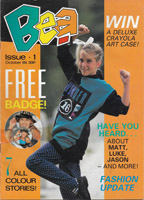 Bea
Bea
(Marvel UK, 21 Sep 1989 to 15 March 1990, 7 issues)
For a long time we thought there was only ever one issue of Bea… but now all seven issues have been found!
Dennis
(Marvel UK, 30 Nov 1989 to 12 Jul 1990, 17 issues)
Reprints of the American Dennis the Menace comic (they couldn’t call this one “Dennis the Menace” because the real Dennis would not have been happy and he’s got a savage-looking dog that never seems to be on a lead).
 Clint
Clint
(Titan Magazines, 02 Sep 2010 to 01 Sep 2013, 23 issues)
Even though it wasn’t that long ago, I know that this comic kind of feels like it never actually existed outside of one those frustrating collecting dreams where you stumble across a whole bunch of comics no one else has ever heard of, but I promise it was real. This happened.
It’s entirely possible that I’ve missed one or two or more titles that really should be included, but even so I don’t expect the margin of error to be any more than about 693%.
It should go without saying that the concept of a “girl’s name” or a “boy’s name” is entirely artificial and arbitrary. Names are just labels and it’s only tradition that guides the manner in which we apply them. Likewise, the concept of gender-specific comics exists only because of tradition (“but we’ve always done it that way”) and fear (“if my son reads comics about female characters he might get some, you know, funny ideas…”), both of which can be fairly easily overcome, and should be.
In the final analysis, what are the figures? Do the comics with girls’ names as their titles greatly outweigh the comics with boys’ names as their titles?
Yes, they do indeed, as if there were ever any doubt. There are forty-three comics on the list, and here’s how it breaks down:
Girls’ names: 29 (67.44%)
Boys’ names: 10 (23.26%)
Androgynous names: 4 (9.30%)
And here’s the same data on a pie-chart…
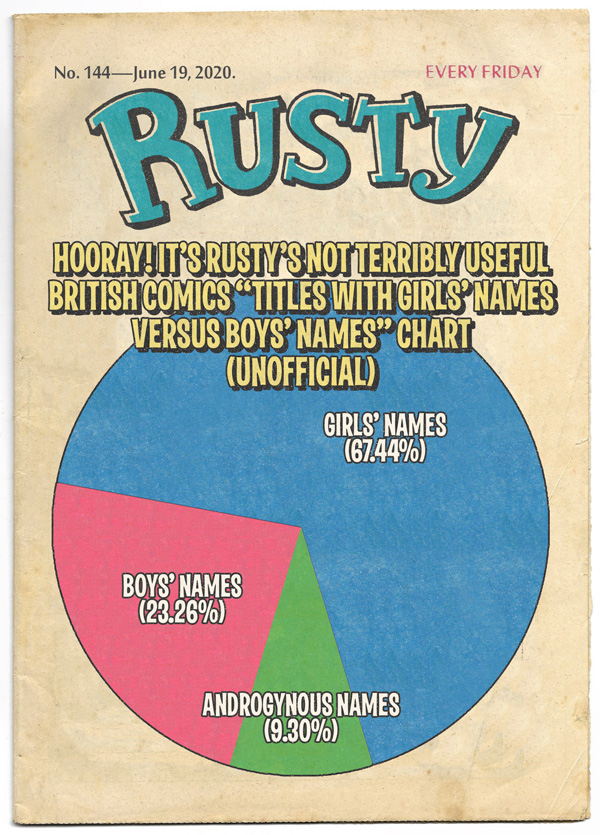

Jackie is named after the author Jacqueline Wilson, who at the time worked for DC Thomson.
LikeLike
This is true! I guess I ought to have mentioned that in the article!
LikeLike
I think that the drawing of your alternate-Earth father-in-law looks a lot like the young Connor MacLeod, or Russell Nash as I knew him at the time.
LikeLike
Excellent work, Mr Carroll! Invaluable comics analysis and your funniest post to date – and I thought your dissection of Look-In was hilarious. Probably far more entertaining than reading the actual comic…
Although it may not be the name she was given at birth, you can find a Lindy (Stevens) and her quality pop tune ‘Penny Gold’ here: https://www.youtube.com/watch?v=OmL7gBezIpQ
I believe she is, indeed, a real person but I suspect that may not be her in the middle, there.
LikeLike
Hi Paul,
I checked on Discogs and you’re not wrong… there really has been at least one person called Lindy!
https://www.discogs.com/Lindy-Stevens-Pure-Devotion/master/914875
Since you’ve now proven me wrong about something, I’ve brought shame on my family so I’m going to delete the blog and lock myself away in a cave for the rest of my life.
That’s on you, mate.
LikeLike
I agree, the Lindygate scandal has dealt a devastating blow to the comics industry and to the blogosphere both but, in time, I think we can all learn to forgive and forget, to put this behind us and move on. The great good you’ve achieved far outweighs this singular betrayal so don’t head for the cave just yet.
LikeLike
What was that, sorry? I can’t hear you from this far back in the cave…
LikeLike
‘There are real people… whose name is Buddy…’ – I’d have thought Buddy Holly was a good start 🙂
LikeLike
Er… I’m not sure what point you’re making there, David, but, yes, Buddy Holly — real name Charles Hardin Holley — was a real person!
(I’ve just spotted my atrocious grammar in that sentence in the blog post, so I’ve fixed that!)
LikeLike
Jinty is a real name: if you spell it with a G (Ginty) it can be short for Virginia, but also it seems there is a classic steam engine type named this (I have to exclude trains when searching for Jinty on ebay). I believe as a name it is more popular in Scotland, so you might have assumed that a comic called by that title was going to be published by DCT, but no.
LikeLike
‘month’ comics (as opposed to monthly comics): March – written by John Lewis, US Congressman (and not UK department store owner). Released by Top Shelf in 2013.
LikeLike